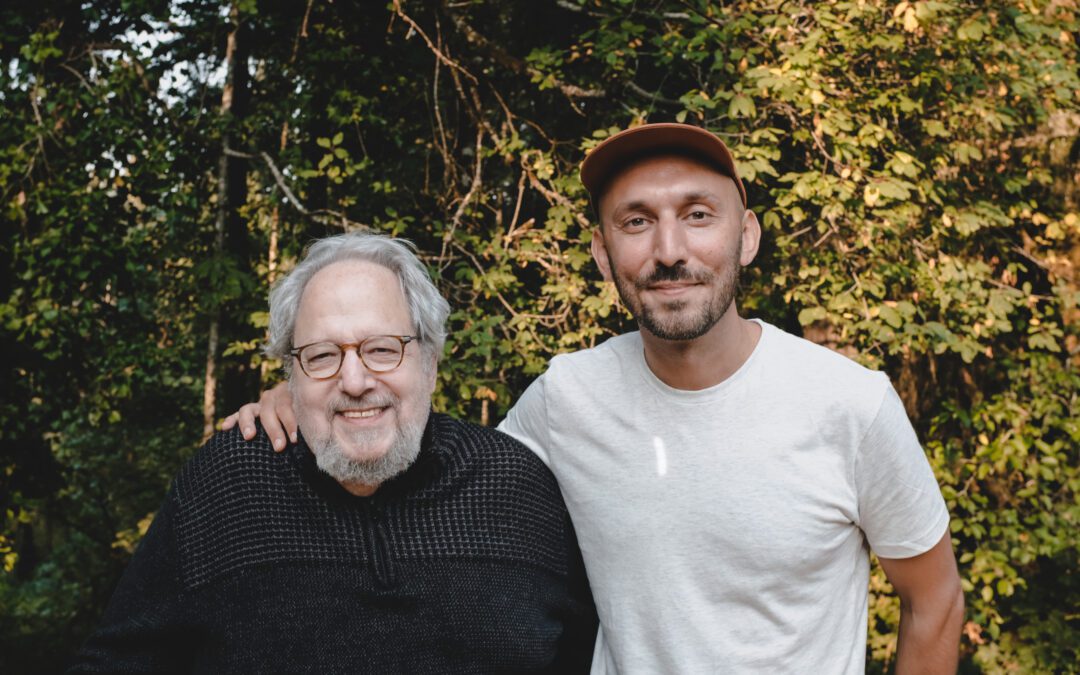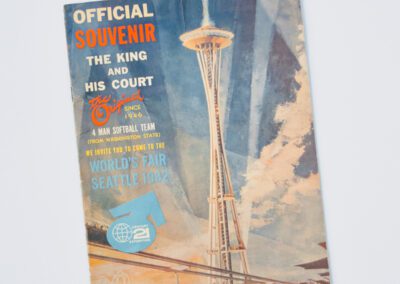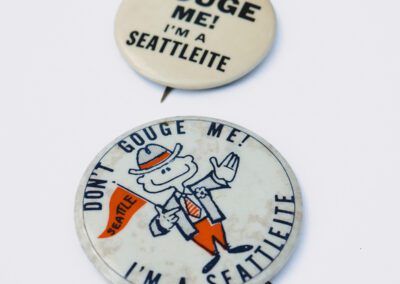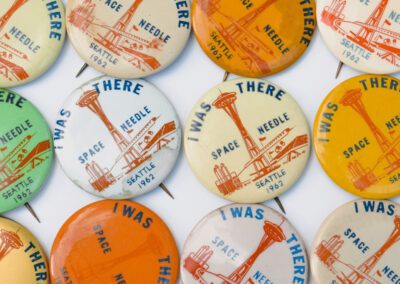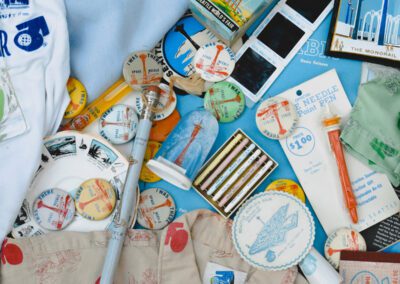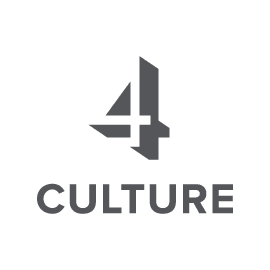By Guest Blogger Zack Bolotin
Zack Bolotin is many things. He is a coffee shop owner (Porchlight Coffee & Records)/illustrator/photographer inspired by the Pacific Northwest as well as mid-century architecture and design. He was born in King County and never left. Zack wrote this piece for Docomomo US/WEWA’s blog to celebrate the 60th anniversary of the Seattle World’s Fair. Zack recently interviewed his father, Norm Bolotin, about his memories of the fair and what that seminal event in Seattle history has meant to him and his family. (The fair ran from April 21 to October 21, 1962.)
Although my childhood took place decades after the Century 21 Exposition closed, I still managed to grow up with the fair. From the juice glasses in the cupboard, to the pennants in the garage, I found the 1962 “Man in Space” logo all around the house long before I knew anything of its meaning. Throughout my entire life, my dad, Norm Bolotin, whose work has been published by Penguin and University of Illinois Press, has also been an avid historian and collector of the Seattle World’s Fair. But it wasn’t until my twenties that my own interest in the fair became more deliberate and a bit more academic. I grew up with two historical non-fiction authors for parents, one grandparent that worked on the fairgrounds and another that worked for a modern architecture magazine in the Sixties—so it isn’t a huge surprise that I eventually dove deep into the Seattle World’s Fair. As I got older, my love for Seattle history and mid-century modern architecture began to intersect with my dad’s personal and professional experience with Seattle World’s Fair history. We now both recognize almost all of the countless souvenirs from the fair, we can walk the grounds of Seattle Center with a mental overlay of the 1962 fairgrounds in our heads and while we’ve both learned much of the same history, we consistently supply one another with new pieces of what we’ve separately learned. He can tell me where a Mold-A-Rama machine was located on the grounds and I can tell him which Alexander Girard and Eames-designed furniture was there. I came up with the idea for our collaborative book 62 Souvenirs as a meeting of our two routes to the fair, intersecting to combine what we have both learned while continuing a family tradition.
ZB: On April 21, 1962, the Century 21 Exposition opened. You were ten at the time and living with your parents in Wallingford. Do you remember when you first caught wind of the fair?
NB: I know it was at least a year before, in the spring of 1961, if not earlier. I spent an awful lot of time at Sick’s Stadium watching the Rainiers with my mom, and the team had Century 21 patches on their sleeves along with a billboard-sized section of the left field wall emblazoned with “Century 21 is Coming!” My mom also helped me send away for brochures and first-day-of-issue stamped envelopes, and so on. I was ecstatic—the world’s fair of the future was coming and I was already a nerdy collector in the making.
ZB: Of the 62 souvenirs in our book, which is your favorite?
NB: That’s tough. It’s hard enough just to come up with a single souvenir that I don’t like. But in the simplest terms, if I had to choose just one to keep, it’d have to be one of the many “I WAS THERE” Space Needle pins—more specifically, the pink one with a small burn mark on the surface. That was my pin in 1962 and when I lost the pin portion from the back, my dad soldered a safety pin on it, and the heat burned through to the front.
ZB: What piece of the fair do you wish you had in your possession?
NB: One piece that I used to have (and would love to have back), is a hand-painted street sign that stood along the wide walkway between the Million Dollar Display and the International Fountain. It was a tall sign with brightly colored plywood arrows attached that pointed visitors toward various attractions: the Gayway, the Coliseum and so on. I can’t recall where I found it but I think I paid around $45 for it in the 1980s. It was pretty huge and there was never a great spot to put it, so around twenty years later I wound up giving it away. At the time, I couldn’t stand it just gathering dust in the garage, but I’ve regretted getting rid of it ever since.
ZB: While architecture probably wasn’t a big interest at just ten years old, which of the buildings at the fair was most memorable?
NB: The building I liked the most was either the Science Pavilion (more specifically the Boeing Spacearium inside the Pavilion) or the colorful, nondescript stalls at the west side of the Gayway. Like most kids, I spent a lot of time with the carnival games and rides packed inside the Gayway.
ZB: Of the fair architecture still standing today, which is your favorite?
NB: It’s not exactly a building, but my favorite structure or “design feature” of the fair would be the Monorail. I really felt like I was somewhere off in the future watching it glide into the fairgrounds from downtown. Even though Alweg manufactured both, I always wondered why the 1959 Disneyland Monorail actually seemed to have a more futuristic look than ours, but I loved it and really still do today. Just watching it go by makes me feel like a kid at the fair again.
ZB: The fair clearly had a big impact on the Seattle we know today. How do you think it most affected the city?
NB: I think the major impact was twofold—Seattle really was a bit of a sleepy city before the fair and it may not have launched us into the 21st century quite yet, but it sure gave us worldwide notoriety in the second half of the 20th. Suddenly we were becoming a big city, already noted for Boeing and Pacific Rim trade, but now recognizable to the rest of the country as a significant city. Secondly, what it did culturally was amazing. While previous fairs may have left a single notable landmark, Seattle gained Seattle Center and along with it the Space Needle, Science Center, Coliseum and more. The fair grounds may have been small in comparison to past expos, but we were left with a very large civic center.
ZB: Your uncle, my great uncle, George Bolotin designed the Blue Spruce apartment building, which was eventually converted into the Administration Building for the fair. Did you know anything about the building back then?
NB: Strangely, I did know that building—but not who had designed it. Your grandfather (George’s twin brother) used to point out buildings that George had designed: a Group Health office, Panorama House Apartments and an apartment near Lake Union (Coronado Apartments), but never mentioned the Blue Spruce. I was only familiar with it because when I was in high school, one of the offices belonged to the new Seattle Supersonics and I interviewed the team’s general manager for an article…for my high school newspaper.
ZB: Our family has some fun ties to the fair. In 1962, your dad was running a machine shop under the Monorail, letting you ride in the back of his Cushman truck through the fairgrounds at night. Fifteen minutes away, your future Father-in-Law and Vice President of Architecture/West magazine, Roscoe Laing, was working on a new issue devoted to the architecture of the Century 21 Expo. Fifty years after that, I was working for Bumbershoot and driving a golf cart around Seattle Center, cruising under the same Monorail and weaving between many of the same buildings from back then. These days I find myself using your knowledge and that same issue of Architecture/West as references for my own research on mid-century modern architecture in Seattle. Why do you think a love of the Seattle World’s Fair has spread so easily in our family?
NB: When one generation truly loved something or some place growing up, somewhere that was so integral to their growth, at the very least they pass along that love and excitement to their kids. The fair was special to both your mom and myself but I just happen to be the kind of person that likes to collect the physical pieces of those memories. That meant that even unintentionally, you got to experience that same collection. And sometimes similar interests lead to coincidences. In high school and after, your mom was already working for her dad at Architecture/West and that sort of imbued her with an interest in architecture and construction. Then when I was twenty-two, my future father-in-law hired me! Everything from the world’s fair to journalism to architecture was intertwined for both of us—and when we had kids, we were so immersed in these things that they became integral parts of your own growing up, even if it was unintentional.
Images: Top – Norm and Zack Bolotin (Zack is on the right.); below – photos of souvenirs featured in the book, 62 Souvenirs.
The King and His Court Program
Souvenir program from a series of softball games played at Seattle’s Sick’s Stadium during the fair. Bolotin Collection | Source: Zack Bolotin
“Don’t Gouge Me!” Buttons
This slogan was popular for local residents as lodging and other costs skyrocketed during the fair. Bolotin Collection | Source: Zack Bolotin
